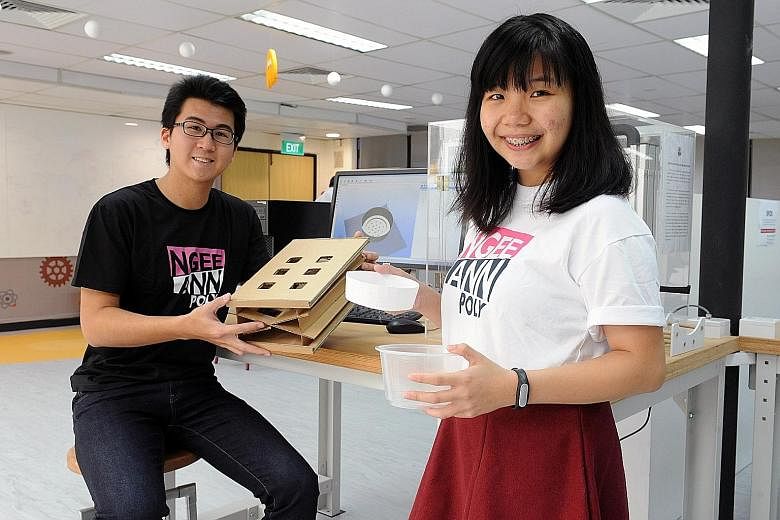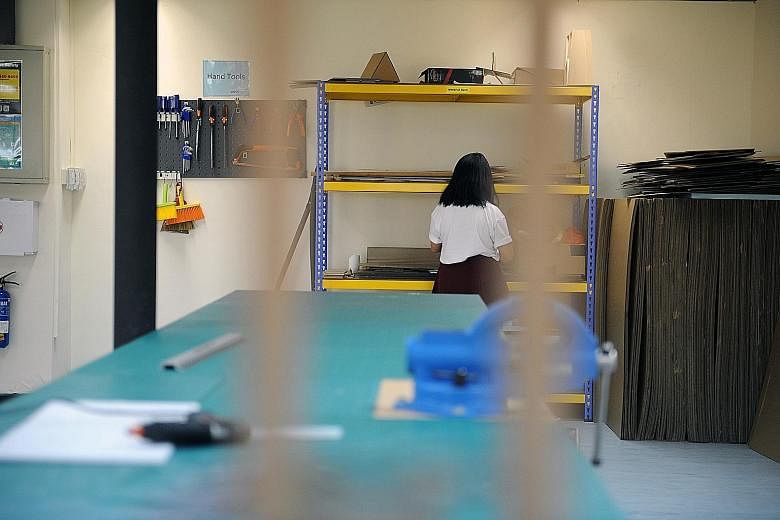A film that turns a smartphone into a 3D screen; a ready-to-drink Singapore Sling; and a smart sensor that tracks elderly patients' movements in the toilet - these are all home-grown products in the market that originated from the country's polytechnics.
Just like universities here, polytechnics are actively commercialising their work, from assistive devices and games to tech applications and health products, and challenging students to solve real-world problems.
In recent years, they have been clinching more licensing deals with companies, filing more patents and starting entrepreneurship programmes for students.
Several, including Nanyang Polytechnic (NYP), have piloted schemes to protect students' projects as they have noticed a growing interest from companies keen to adopt their work.
-
POLYTECHNICS' CREATIVE EFFORTS
-
NANYANG POLYTECHNIC
•About 160 patents in the last 10 years, compared to 57 from 1998 to 2004.
•Clinched 60 licensing deals since 2009.
-
TEMASEK POLYTECHNIC
•Filed 51 patents - six of which were awarded - in the last five years, from financial year (FY) 2010 to 2014.
•From FY2005 to 2009, it filed 40 patents, 16 of which were awarded.
•Its number of licensed projects also doubled from three in FY2005 to 2009 to six in FY2010 to 2014.
-
NGEE ANN POLYTECHNIC
•Awarded six patents from 2010 to 2015, up from two from 2001 to 2009.
•Had 12 licensed projects from 2010 to 2015, compared to none from 2001 to 2009.
-
SINGAPORE POLYTECHNIC
•Filed 23 patents from 2010 to 2015, up from six in the preceding years from 1999, when it filed its first patent.
-
REPUBLIC POLYTECHNIC
•Filed seven patents since 2003 when the polytechnic was first set up, with one patent awarded so far.
•Had 10 projects licensed from 2009 to 2014, and none before that.
These efforts are part of a push by polytechnics for students to go beyond classroom learning and exam results, and be able to think creatively. It is also a chance for students to have a taste of industry projects and the work that goes into filing patents and developing products.
Such a push is even more relevant now as Singapore shifts to an innovation-driven economy, with the Government encouraging firms to adopt new technologies to stay ahead in the global economy.
Dr Valdew Singh, director of NYP's Centre for Technology Innovation and Commercialisation, said: "Students learn to be resourceful, deal with limitations, liaise with companies and address issues on the spot when they are involved in projects.
"Some of these solutions can be adopted by firms."
Dr Lee Mun Wai, senior manager of the Singapore Polytechnic's Food Innovation Resource Centre, said students learn about global and local trends as they interact with researchers and industry experts.
The polytechnics have entrepreneurship or commercialisation centres, which work with various industries to turn research into real-world technologies.
NYP, which set up a centre for tech commercialisation and licensing in 2008, has had 60 licensing deals since 2009.
Among the polytechnics, it has also filed the most number of patents - about 160 in the last 10 years, compared with 57 from 1998 to 2004. Its first patent was filed in 1998.
A patent is a right granted to an invention's owner that prevents others from making, using, importing or selling the invention without permission.
In the last decade, Temasek Polytechnic's office of research and technology has worked on more than 150 research and development projects with industry partners, some of which led to patented inventions.
It filed 51 patents in the last five years, from the financial year (FY) 2010 to 2014, up from 40 patents from FY2005 to 2009.
The polytechnics are also providing students with the space to take their ideas further. For instance, Ngee Ann Polytechnic set up an innovation and entrepreneurship office called The Sandbox last year for students to brainstorm and test their projects.
Mr Gaines Goh, a third-year business studies student at Ngee Ann Polytechnic (NP), worked on a project in sustainable cardbox packaging at The Sandbox last year.
"The school is very encouraging and lets us try out ideas. Whether we fail or succeed, it helps us reflect on the process of learning and trying," said the 20-year-old.
Along with two friends from the National University of Singapore (NUS), he developed an integrated smart terminal that indicates to bus drivers that there are elderly and people with disabilities who want to board their bus, so they can have an easier time boarding when the buses arrive.
He is in talks with the Infocomm Development Authority of Singapore to develop this idea further.
Some of the polytechnics attach students with lecturers to guide them through their ideas. They also provide financial help to students who need funding for projects.
Since 2010, NP has supported about 250 student projects - each with a funding cap of $2,000 - to help students develop their ideas.
In January last year, NYP set aside $20,000 to protect students' works, as part of a pilot scheme to recognise and protect selected works of design students. It is currently reviewing 10 projects.
Its spokesman said it started the scheme as it had in recent years received more requests to commercialise students' works that were displayed at public exhibitions. It also wanted to educate students on intellectual property issues.
Polytechnic students also learn about innovation in research projects. For instance, third-year biotechnology student Charmaine Lee was one of five Republic Polytechnic (RP) students who were part of a project last year to develop a diagnostic kit that can differentiate between the dengue and chikungunya viruses in a single test.
The kit was devised by researchers from NUS and RP, who are in talks with biotechnology companies about its commercial potential.
Ms Lee, 19, said the experience gave her a glimpse of what working as a researcher on a project with commercial potential feels like. "I learnt new techniques, mainly technical, on how to run tests, how to operate machines and read results."
Mr Goh said: "Innovation and research is a stepping stone to developing yourself and the country.
"If people stick to the plain-old desk jobs and don't think out of the box, there will be no development, no latest technologies."
He added: "It also teaches you to never give up, even though you may fail many times."
Sticker sensor detects cracks in glass doors, windows



